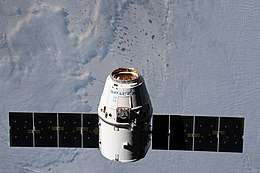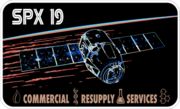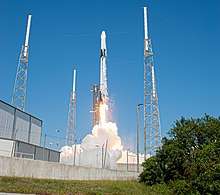SpaceX CRS-19
SpaceX CRS-19, also known as SpX-19, was a Commercial Resupply Service mission to the International Space Station.[4] The mission is contracted by NASA and was flown by SpaceX on a Falcon 9 rocket.
 Dragon C106.3 approaches the ISS | |
| Mission type | ISS resupply |
|---|---|
| Operator | SpaceX |
| COSPAR ID | 2019-083A |
| SATCAT no. | 44821 |
| Mission duration | 32 days, 22 hours, 12 minutes |
| Spacecraft properties | |
| Spacecraft | Dragon C106.3 |
| Spacecraft type | Dragon CRS |
| Manufacturer | SpaceX |
| Dry mass | 4200 kg |
| Dimensions | Height: 6,1 m Diameter: 3.7 m |
| Start of mission | |
| Launch date | 5 December 2019, 17:29:24.521 UTC [1] |
| Rocket | Falcon 9 |
| Launch site | Cape Canaveral, SLC-40 |
| Contractor | SpaceX |
| End of mission | |
| Disposal | Recovered |
| Landing date | 7 January 2020, ??:?? UTC |
| Landing site | Pacific Ocean |
| Orbital parameters | |
| Reference system | Geocentric |
| Regime | Low Earth |
| Inclination | 51.6° |
| Berthing at ISS | |
| Berthing port | Harmony [2] |
| RMS capture | 8 December 2019, 10:05 UTC [1]·[2] |
| Berthing date | 8 December 2019, 12:47 UTC [1]·[2] |
| Unberthing date | 7 January 2020, 08:41 UTC |
| RMS release | 7 January 2020, 10:05 UTC [1] |
| Time berthed | 29 days, 19 hours, 54 minutes |
| Cargo | |
| Mass | 2617 kg [3] |
| Unpressurised | 924 kg [3] |
| Fuel | 650 kg [1] |
| Gaseous | Oxygen: 50 kg [1] |
| Water | 420 kg [1] |
 SpaceX CRS-19 mission patch | |
Dragon capsule C106 made its third flight on CRS-19 having previously flown on CRS-4 and CRS-11. Dragon successfully returned to Earth on January 7, 2020 after a month-long stay at the ISS.
Launch schedule history
On February 2016, it was announced that NASA had awarded a contract extension to SpaceX for five CRS additional missions (CRS-16 to CRS-20).[5] In June 2016, a NASA Inspector General report had this mission manifested for December 2018.[6] The mission was later delayed to 15 October 2019,[7] but launched in December 2019.[4]
On 5 December 2019, CRS-19 launched successfully, followed by a successful first stage landing on the barge Of Course I Still Love You.[8]
Payload

NASA has contracted the CRS-19 mission from SpaceX and therefore determines the primary payload, date/time of launch, and orbital parameters for the Dragon space capsule. According to a February 2018 press release, the external payload manifested for this flight is the Hyperspectral Imager Suite (HISUI)[9] which is planned for the Japanese Kibo module.
A Lithium-Ion Battery to replace one that failed (shipped on HTV 7) on ISS truss is also on board and is to be connected to the station by the crew during an upcoming spacewalk.
The following is a breakdown of cargo bound for the ISS:[3]
- Science investigations: 977 kg (2,154 lb)
- Vehicle hardware: 306 kg (675 lb)
- Crew supplies: 256 kg (564 lb)
- Spacewalk equipment: 64 kg (141 lb)
- Computer resources: 15 kg (33 lb)
- External payloads: HISUI and replacement lithium battery 924 kg (2,037 lb)
The Dragon spacecraft is carrying 2,617 kilograms (5,769 lb) of equipment to the station, including 977 kg (2,154 lb) of samples and scientific research instruments, including experiments on combustion, an upgrade for the Cold Atom Lab and 40 genetically enhanced mice.[10][3]
References
- Expedition 61
- "Space Station – Off The Earth, For The Earth". blogs.nasa.gov. Retrieved 2019-12-08.
- Clark, Stephen. "SpaceX resupply mission reaches International Space Station – Spaceflight Now". Retrieved 2019-12-09.
- "Launch Schedule". Spaceflight Now. 11 February 2019. Retrieved 17 February 2019.
- de Selding, Peter B. (24 February 2016). "SpaceX wins 5 new space station cargo missions in NASA contract estimated at $700 million". Space News. Retrieved 24 February 2016.
- NASA Office of Inspector General (June 28, 2016). NASA’s Response to SpaceX’s June 2015 Launch Failure: Impacts on Commercial Resupply of the International Space Station (PDF) (Report). NASA Office of Inspector General. p. 13. Retrieved 2016-07-18.
- Pietrobon, Steven (November 13, 2018). "United States Commercial ELV Launch Manifest". Retrieved November 13, 2018.
- "CRS-19 Mission". YouTube.com. Space Exploration Technologies Corp. Retrieved 5 December 2019.
- "Falcon 9 scrubs launch of CRS-19 Dragon to the ISS". NasaSpaceFlight. 4 December 2019. Retrieved 5 December 2019.
- "After quiet autumn, SpaceX preps for busy December launch schedule". 25 November 2019. Retrieved 25 November 2019.

.jpg)

